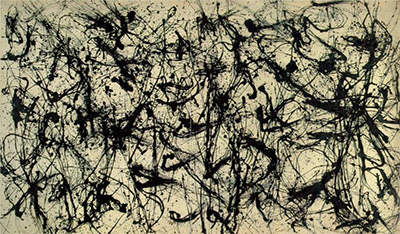Number 32’s distinction from Pollock’s other work is the simple monochromatic use of black paint. While lighter colours support this, the overall effect creates a sense of movement and spontaneity in his artworks.
Although Number 32 (1950) uses lighter colour to emphasis the black paint, it is a long way from the earlier Pollock style, where colours were interwoven in complex interactions and layers (see Number 1A in 1948 or Lavender Mist in 1950 for examples of this palette complexity, where at least seven colours were applied, blended and layered together).
As a so-called drip painting, there are areas where the unprimed canvas has completely absorbed the black paint. In addition, there are areas bordering the saturated canvas where the paint is raised, creating glossy textures, ridges and what could be interpreted as geometric patterns.
As with many of Pollock’s paintings, there is no obvious theme or subject. Instead, as the viewer studies, scans and examines the entire painting, their eyes are drawn to the centre of the canvas, as instinctively they follow the tangled interactions of the black lines: almost like untangling a ball of wool.
This never-ending, rollercoaster effect as your eyes follow the black trails, creates dizzying movement (similar to the magic eye puzzles of the 1990’s), as you begin to admire Pollock’s technique at covering a large space with such a dense weave, which escapes off the end of the canvas.
To create such a visually striking painting, Pollock spread the giant canvas flat on the floor and walked and moved around the perimeter, while experimenting with new tools and techniques to flick and drip paint.
In addition as using sticks and utensils, he would pour the paint directly from the pot, and let it settle, marveling in the randomness and chaotic creation.
Although Pollock’s Number 32 may appear to be a random, unplanned and chaotic creation, it seems that he spontaneously and consciously returned to the painting to delicately modify lines.




